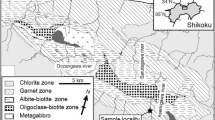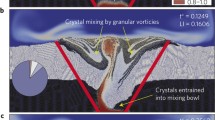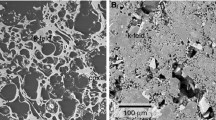Abstract.
Compaction in the Holyoke flood-basalt flow is modeled using a quantitative phase equilibrium routine based on the MELTS algorithm that is coupled with compaction-driven heat and mass transport equations. For a crystal–liquid mush that is cooling from both the top and the bottom, the compaction is qualitatively different in the upper and lower parts of the flow. The solid fraction in the lower part increases as a result of concurrent compaction and solidification. In contrast, cooling from the upper boundary results in an increase in viscosity and a decrease in permeability toward the top. This causes the velocity of the solid matrix to increase downward and the upper part to undergo dilation of the solid matrix. The result is an "S"-shaped profile for compatible elements, and an inverse profile for incompatible elements. The region of modeled maximum dilation matches the location of segregation sheets in the Holyoke flow. Discrepancy between observed deformation, as calculated from textural deformation of plagioclase chain networks versus compositional profiles, suggest some crystal accumulation and/or compaction prior to the formation of the plagioclase chains.
Similar content being viewed by others
Author information
Authors and Affiliations
Additional information
Electronic Publication
Rights and permissions
About this article
Cite this article
Boudreau, A., Philpotts, A.R. Quantitative modeling of compaction in the Holyoke flood basalt flow, Hartford Basin, Connecticut. Contrib Mineral Petrol 144, 176–184 (2002). https://doi.org/10.1007/s00410-002-0391-4
Received:
Accepted:
Issue Date:
DOI: https://doi.org/10.1007/s00410-002-0391-4




